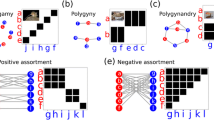Abstract
Quite different sets of data are shown to generate identical output ratios so that analyses of mating behavior data based on the use of input and output ratios may obscure significant aspects of the mating behavior.
Similar content being viewed by others
References
Adams, W. T., and Duncan, G. T. (1979). A maximum likelihood statistical method for analyzing frequency-dependent fitness experiments.Behav. Genet. 9:7–21.
Ayala, F. J. (1972). Frequency-dependent mating advantage inDrosophila.Behav. Genet. 2:85–91.
Lewontin, R., Kirk, D., and Crow, J. (1968). Selective mating, assortative mating, and inbreeding: Definitions and implications.Eugen. Q. 15:141–143.
Merrell, D. J. (1950). Measurement of sexual isolation and selective mating.Evolution 4:326–331.
Merrell, D. J. (1960). Mating preferences inDrosophila.Evolution 14:525–526.
Peterson, J. R., and Merrell, D. J. (1983). Rare male mating disadvantage inDrosophila melanogaster.Evolution 37:1306–1316.
Author information
Authors and Affiliations
Rights and permissions
About this article
Cite this article
Merrell, D.J. The analysis of mating behavior data. Behav Genet 14, 153–156 (1984). https://doi.org/10.1007/BF01076411
Received:
Accepted:
Issue Date:
DOI: https://doi.org/10.1007/BF01076411




